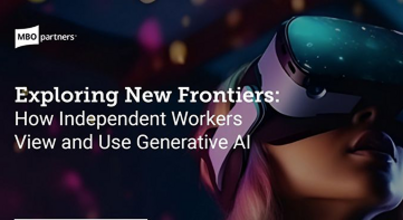- All
- Enterprise Guides
- Research
- Talent Guides
- Templates
- Tools
- White Papers
Want to read this report? Access MBO’s reports to stay up-to-date on the latesttrends in the independent…
Candidate fraud is an increasing concern for many organizations, making it more difficult to confidently evaluate new…
Want to read this report? Access MBO’s reports to stay up-to-date on the latesttrends in the independent…
15 Years, One Movement The Returnon Independence “For fifteen years, this report has tracked what is now…
Talent Sourcing Snapshot Take a Closer Look at How You Source Talent This quick, guided survey helps…
Writing a client report is essential for communicating your progress on a project while managing expectations and…
Creating a direct sourcing program from scratch is often out of reach for SMBs. Partnering with experts…
Struggling to manage independent contractors while staying compliant? Learn how an Agent of Record (AOR) can streamline…
DOWNLOADTHE REPORT The Independent by Choice Movement: Authentic and Intentional State of Independence in America 2024…
Learn how to write and deliver proposals as a consultant.
Learn how to decide if it’s time to grow your business, what to consider, and how to…
After landing your first consulting project, take these 10 steps to set yourself up for success.
Approach your presentation from a storytelling perspective. Stories are a powerful communication tool that engage your audience…
Discover how an Employer of Record (EOR) can streamline hiring, reduce compliance risk, and help you build…
Learn the advantages of engaging independent contractors vs. temporary workers or full-time employees.
Contingent Workforce Program Maturity Assessment Get a clear snapshot of your contingent workforce program MBO’s Program Maturity…
Learn what causes independent contractor engagement risk and how to mitigate that risk.
Discover the steps you can take to land your first consulting client.
There are many benefits in hiring or engaging offshore workers to complete tasks and provide services for…
Ask yourself these important questions before starting a consulting business.
Compare independent contractor engagement alternatives to find the one that works best for you.
Learn how to easily create a professional website, stand out from your competition, and reach new clients.
This guide covers best practices for a company and its managers to set up their independent talent for success in 2023. These practices are part of building an optimized workforce. It also includes self-assessments that help determine what’s working and where improvement is needed.
Learn how to decide if you’re ready to be self-employed and the steps to take to prepare…
See how to overcome a common roadblock to independent consulting success.
The world of work has been evolving for some time, influenced by technologies and societal shifts. As…
Learn how to engage contractors using best practices that reduce costs, attract top talent, and reduce misclassification…
Find a step-by-step guide on creating a Scope of Work document that outlines the basic details of…
Certified Self Employed (CSE) A new vision for America’s independent workforce The growth and innovation of the…
Blueprint for becoming a Client of Choice Elevate: A blueprint for modern independent workforce management With the…
Digital nomad sponsor template Do the work you love, how and where you want. Use this template to…
Understand six common business frameworks for consultants, self-employed professionals, and independent contractors.
Learn how to enhance your reputation and elevate your business by developing a thought leadership platform.
Modern independent consultants need to adapt quickly, especially as client organizations evolve and change.
Independent Contractor Risk Assessment Is Important Independent contractor misclassification is a critical issue when engaging contingent workers….
Learn the key steps to craft a reputation management plan and maintain a strong professional presence.
To succeed in today’s market, independent consultants need to understand how to develop and market a strong…
Digital Nomads One in Ten U.S. Workers is a Digital Nomad The MBO Partners 2024 State of…
Setting your bill rate is key for independent contractors looking to enhance their business success. Use these…
The number of people working as independent professionals in the U.S. is steadily rising. As the independent…
Learn the steps to take if your company is audited and 15 best practices to implement to…
As the project-based economy continues to evolve, managing independent contractor talent effectively will be critical.
As the use of independent professional labor continues to grow, so does the need for more efficient…
The Untapped Potential of a Recomposable Workforce Why Leaders Need To Redefine The Structure Of Their Workforce…
Using a consulting fees calculator can help you understand how much to charge for your services. As…
Find the tools that you need to plan and launch a direct sourcing program in your enterprise.
Exploring New Frontiers: How Independent Workers View and Use Generative AI This brief covers the results of…
Corporate Digital Nomad Policy: Best practices and guidelines Digital nomads are a mobile and skilled workforce. As more…
Creator Economy Creators Plateau, But Remain a Vibrant Independent Force Independent Creators Plateaued in 2023 The creator…
2024 Trends | Part 1 The Macro Market & Workplace Realities 2024 promises to be a year…
2024 Trends | Part 2 Positioning for the Future of Work The future of work is here,…
DOWNLOADTHE REPORT Stronger Together Introduction: In 2023, the state of the independent worker is stronger. In…
Unleash the Power of Direct Sourcing: Pave Your Pathway to Workforce Optimization Download the Report Take Your…
Digital Nomads Digital nomads defy a single definition, yet all choose to combine working remotely and traveling…
For years, the balance of power has been shifting. As the self-confidence and self-assurance of independent professionals…
Creator Economy Staking Out New Territory Independent digital content creators are among the fastest-growing self-employment and independent…
Building an Agile Workforce in a Post-COVID World Shift to a strategic mindset through workforce optimization The…
Four forces driving the new world of work Workforce optimization initiatives are shifting the mindset of enterprises…
Post-pandemic, people are rethinking how work fits into their broader life goals. We referred to these changes…
The Contingent Labor Imperative: How Agile Enterprises Succeed in a Modern Workforce Model August 2022…
WORKFORCE TRENDS Digital Nomads: Advancing the Next Way of Working READ THE RESEARCH BRIEF DOWNLOAD THE 2021…
Company-Branded Talent Marketplaces Overview Where we are today Enterprises today are facing chronic skill shortages, especially for…
COVID-19 and the Rise of the Digital Nomad The 2020 report covers how COVID-19 led to a…
Digital Nomads: Leading Remote Work State of Independence: 2019 Research Brief Digital nomads are leading the shift…
Digital Nomads: Leading the Trend for Remote Work State of Independence: 2018 Research Brief Technology is enabling…
Accelerating customer outcomes
From talent access to contingent workforce management, 700+ global companies trust MBO Partners to navigate the future of work.





































































